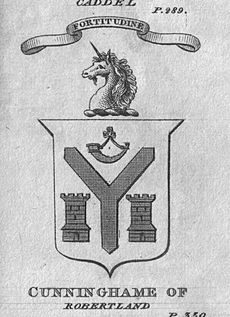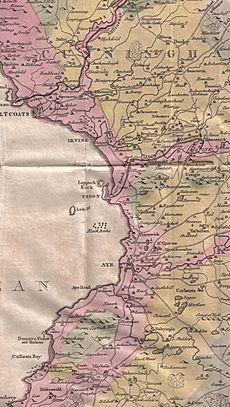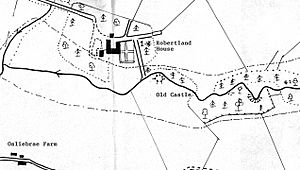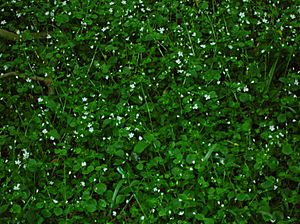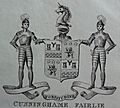Castle and Barony of Robertland facts for kids
Robertland Castle and Estate is a historic place found near Stewarton in East Ayrshire, Scotland. It includes the remains of an old castle and a more modern house, both with interesting stories. This area was once part of the ancient district of Cunninghame.
Contents
The Story of Robertland Castle
Robertland Castle was once a strong fortress belonging to a branch of the Cunninghame family. Today, only a few ruins remain. In the 1600s, it was called 'Over Robertland'. By 1800, most of the castle stones were used to build the walls of a garden at Robertland House. These garden walls can still be seen today.
The old castle was a huge square building, six storeys tall. The ground floor was used for animals like cattle and horses. Servants lived on the second floor, and the family lived on the upper floors. A moat surrounded this defensive castle. This moat could be filled with water from the nearby Swinzie Burn, making it harder for enemies to attack.
Why Was Robertland Castle Destroyed?
It is believed that the Montgomeries, another powerful family, burned the castle down. This happened after the 4th Earl of Eglinton was murdered in Stewarton in 1586. This event was part of a long-standing rivalry between the Cunninghame and Montgomerie families.
In 1962, experts visited the site. They noted that the castle and its courtyard stood on a steep bank of the Swinzie Burn. The remaining walls were thick, about 1.6 meters wide. Inside, the castle seemed to be divided into two parts.
Hidden Treasures: Carved Stones
Many carved stones have been found in the old moat. These stones are now kept in the garden wall. They include a Gargoyle (a decorative stone spout), a rounded sandstone projectile, and a stone with a mason's mark (a symbol used by the builder). One stone in the garden wall is dated 1597. It also has a Latin sentence: Vita post fine eraverit, which means "There will be life after the end."
The home farm building has the letters D.M.C. and the date 1018, though this date seems very old for the building. A dovecot, a building for pigeons, was also part of the estate. The land around Robertland was enclosed with hedges and ditches around 1764.
Who Owned Robertland Castle?
In 1607, areas like Over, Nether Castleton, and Fulshaw were part of the Robertland estate. They were owned by David Cunninghame and his family. Other lands, like Over Lochrig and Waterland, also belonged to the estate at different times. In 1770, the lands and Barony of Robertland were sold.
Robertland House and Estate
Around 1813, a wealthy tobacco merchant from Stewarton, Alexander Kerr, bought Robertland. He built the current Robertland House in 1820. After he passed away, his son John James inherited the property. He then rented it out to different people.
In 1823, it was noted that the "remarkably lofty house of six stories" had been taken down. This suggests that a tall house was built after the old castle was demolished. This tall house was then replaced by the current Robertland House, built around 1820.
The Design of Robertland House
The Robertland House we see today was designed in 1820 by David Hamilton. He was a famous architect who also designed Dunlop House. Alexander Kerr, the owner, hired Hamilton for the design. The house has a classic look with a triangular roof section called a pediment and decorative columns called pilasters.
After Alexander Kerr, his son John James Kerr took over in 1847. Many important people rented the house over the years. In 1914, the mansion was damaged by a fire. It was then fully repaired and updated, becoming the house it is today.
The Estate Lands
In 1913, the Robertland estate was put up for sale. It was a very large property, covering about 2,243 acres (about 9 square kilometers). This included woodlands, mossy areas, and 26 farms. Many smaller places, like Nether Robertland, Fulshaw, and Pokelly, were part of the estate at that time.
One well-known resident was Dr. John Cunningham. His family later gave the Cunningham-Watt Park to Stewarton, which is still enjoyed by the townspeople. More recently, the estate has been owned by different individuals, including Alan Burns Williamson and Brian Douglas Parsons.
How to Access Robertland
An old road used to cross the Annick Water near a place called 'the castle' in Stewarton. This road led up to Robertland Castle. Today, this old access no longer exists. The main driveway now runs from a gatehouse on the Old Glasgow Road. It crosses the Annick Water using the Robertland Bridge.
Robertland and the Suffragettes
On March 12, 1914, while Robertland House was empty and waiting for a new owner, two suffragettes broke in. They started a fire in the building. The fire brigade had trouble finding water, and the front of the house was badly burned. However, the back part and other buildings were saved, and the front was rebuilt.
The suffragettes left postcards explaining why they did this. They said it was revenge for actions against Mrs. Emmeline Pankhurst, a leader in the women's vote movement. They also wanted to pressure the church to support votes for women. Their footprints were followed in the snow, leading to a car they had parked. They then escaped towards Glasgow. This event was reported in newspapers across the country.
Important People of Robertland
The Cunninghame family of Robertland started with David Cunninghame of Bartonholme. He was the son of William Cunninghame of Craigends.
In 1526, King James V gave Robertland to Henry Kempt. However, by 1556, Lord Semple owned the lands.
The Cunninghames and the Earl of Eglinton
David Cunninghame of Robertland, married to Margaret Cunninghame, was involved in the killing of Hugh, Earl of Eglinton. After this, he was sent away to Denmark. He was later pardoned when King James VI married Anne of Denmark. A stone in the garden, showing the Royal Arms of Scotland, remembers this royal wedding. Margaret Cunninghame, who was important in the assassination, came from Aiket Castle. David Cunninghame of Robertland was married to one of her sisters.
David Cunninghame's son, also named David Cunninghame, became the Master of the King's Works in Scotland. This meant he was in charge of royal buildings. He might have been an architect. He followed King James VI to England and was knighted in 1604. He was made a Baronet of Nova Scotia in 1630.
Later, Diana Cunninghame, an only daughter of another Sir David, married Thomas Cochrane. Much of the estate was sold around this time in the mid-1600s.
In 1672, Alexander Cunninghame inherited Robertland. He married the heiress of John Cunninghame of Kilmarnock. Alexander had three children. Later, Sir William Cunninghame of Auchinskeith gained the property by marrying Margaret Fairlie of Fairlie in the 1700s.
The owners of Robertland, like other important families, often had a town house in Irvine.
Robert Burns' Visits to Robertland
Robertland was the Ayrshire home of Sir James Hunter Blair, 1st Baronet. He was a banker and politician who helped the famous poet Robert Burns. Burns even mentioned him in his poem, Elegy on the death of Sir James Hunter Blair.
Burns also visited Robertland House. During one visit, he is said to have revealed that the character of Tam O'Shanter was based on a real person named Douglas Graham. John Smith of Swindridgemuir wrote in 1829 that he was there when Burns shared this secret. Sir William Cunninghame of Auchinskeith, who owned Robertland at the time, also invited Burns to the estate.
Burns was also researching the song 'The Lass of Peaty's Mill'. During a visit to Robertland, Sir William Cunninghame told him the story behind the song. The Earl of Loudoun was walking with his son and the poet Allan Ramsay near 'Patie's Mill'. They saw a beautiful young country girl working in the hay. The Earl said she would be a great subject for a song. Allan Ramsay then quickly wrote the song.
It is thought that Robert Burnes, the poet's uncle, worked as the Land Steward for the Robertland estate.
The Murder of the 4th Earl of Eglinton
A traditional story tells of the death of the Earl of Eglinton. The Earl was on his way to visit the laird of Robertland Castle. He stopped first at Lainshaw Castle. The Laird of Lainshaw, a Montgomerie, tried to convince him not to continue his journey. However, the Earl did not listen. On his way back from Robertland, he was met and murdered by Cunninghame of Aiket Castle. This happened at a place called the Windy-path in Stewarton. He was shot but managed to stay on his horse until he reached the Annick Ford. There, he fell from his horse and died. The Windy-path has been called the 'Mourning or weeping-path' ever since.
Nature at Robertland
James Forrest, a well-known botanist, found the rare Adder's tongue Fern in the Swinzie Burn glen at Robertland in the 1920s.
The Stewarton Flower, also known as Pink Purslane (Claytonia sibirica), is common in damp areas around Stewarton. It was named the Stewarton Flower because it grew so much there. This plant originally came from North America. It was likely introduced to Scotland at the Robertland Estate.
Interesting Facts about Robertland
The name Robertland likely means "Robert's Lands." The name Swinzie (or Sinzie) for the burn might mean something that cuts between two other things, as the burn cuts a valley through the hillside.
In 1670, Sir Alexander Cunninghame had some of his horses taken to pay a debt. They were brought to Irvine to be sold. Sir Alexander gathered twenty men to get his horses back. A fight broke out, and one man, John Reid, attacked Alexander Kennedy, who died later. Several shots were fired before Robertland's group rode away. John Reid was not punished for his actions.
In the Stewarton Laigh Kirk graveyard, there is a unique tombstone for Jane Watt, who died in 1857. It is a large, horizontal tombstone made of cast-iron.
There was once a Nether Robertland mill in Stewarton and a Robertland Brewery in Kilmarnock.
The Queen Victoria Jubilee was celebrated in a field at Robertland. School children walked there to play games and have foot races.
In 1808, it was recorded that Sir William Cunningham of Robertland found three areas of coal that could be mined on his land.
Images for kids


